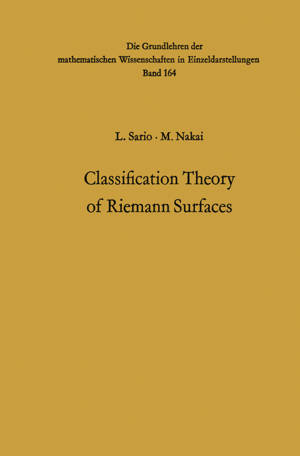
- Afhalen na 1 uur in een winkel met voorraad
- Gratis thuislevering in België vanaf € 30
- Ruim aanbod met 7 miljoen producten
- Afhalen na 1 uur in een winkel met voorraad
- Gratis thuislevering in België vanaf € 30
- Ruim aanbod met 7 miljoen producten
Zoeken
Omschrijving
The purpose of the present monograph is to systematically develop a classification theory of Riemann surfaces. Some first steps will also be taken toward a classification of Riemannian spaces. Four phases can be distinguished in the chronological background: the type problem; general classification; compactifications; and extension to higher dimensions. The type problem evolved in the following somewhat overlapping steps: the Riemann mapping theorem, the classical type problem, and the existence of Green's functions. The Riemann mapping theorem laid the foundation to classification theory: there are only two conformal equivalence classes of (noncompact) simply connected regions. Over half a century of efforts by leading mathematicians went into giving a rigorous proof of the theorem: RIEMANN, WEIERSTRASS, SCHWARZ, NEUMANN, POINCARE, HILBERT, WEYL, COURANT, OSGOOD, KOEBE, CARATHEODORY, MONTEL. The classical type problem was to determine whether a given simply connected covering surface of the plane is conformally equivalent to the plane or the disko The problem was in the center of interest in the thirties and early forties, with AHLFORS, KAKUTANI, KOBAYASHI, P. MYRBERG, NEVANLINNA, SPEISER, TEICHMÜLLER and others obtaining incisive specific results. The main problem of finding necessary and sufficient conditions remains, however, unsolved.
Specificaties
Betrokkenen
- Auteur(s):
- Uitgeverij:
Inhoud
- Aantal bladzijden:
- 450
- Taal:
- Engels
- Reeks:
- Reeksnummer:
- nr. 164
Eigenschappen
- Productcode (EAN):
- 9783642482717
- Verschijningsdatum:
- 31/05/2012
- Uitvoering:
- Paperback
- Formaat:
- Trade paperback (VS)
- Afmetingen:
- 156 mm x 234 mm
- Gewicht:
- 653 g

Alleen bij Standaard Boekhandel
+ 211 punten op je klantenkaart van Standaard Boekhandel
Beoordelingen
We publiceren alleen reviews die voldoen aan de voorwaarden voor reviews. Bekijk onze voorwaarden voor reviews.








